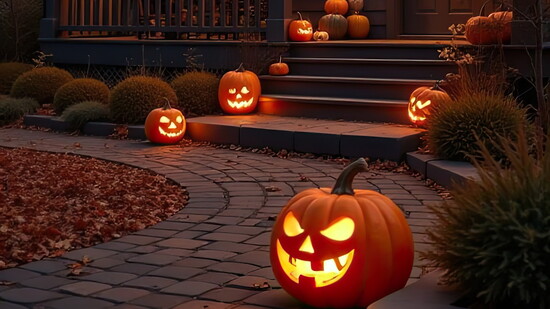The History and Evolution of Halloween
Halloween is a holiday celebrated each year on October 31, and in 2025, it falls on a Friday. Best known for costumes, candy, and spooky fun, Halloween has a deep history that stretches back thousands of years to ancient Celtic traditions.
Ancient Origins: The Festival of Samhain
Halloween traces its roots to the ancient Celtic festival of Samhain (pronounced "sow-in"), which marked the end of the harvest season and the beginning of winter—a time often associated with death. Celebrated in what is now Ireland, the United Kingdom, and northern France, Samhain was observed on the night of October 31. The Celts believed that on this night, the boundary between the worlds of the living and the dead became blurred. Spirits were thought to return to Earth, and people lit bonfires and wore costumes to ward off roaming ghosts.
From All Hallows Eve to Halloween
By the 8th century, Pope Gregory III designated November 1 as All Saints Day, a time to honor saints and martyrs. The night before became known as All Hallows Eve, eventually shortened to Halloween. Over time, All Saints Day adopted some of the traditions of Samhain, blending Christian and pagan practices. This transformation helped Halloween evolve into a holiday of both reverence and revelry.
Halloween Comes to America
Halloween was not widely celebrated in colonial New England due to the strict religious beliefs of Puritan settlers. However, it was more common in southern colonies like Maryland, where a mix of European, Native American, and African cultures began to shape uniquely American Halloween customs.
One of the earliest forms of celebration in America was the "play party"—a gathering to celebrate the harvest where neighbors shared ghost stories, told fortunes, and sang. These social events planted the seeds for today’s Halloween parties.
In the mid-1800s, a surge of Irish immigrants fleeing the Potato Famine brought their Halloween traditions to the U.S., including the practice of trick-or-treating and costume-wearing. These customs spread quickly and began to take hold across the country.
The Rise of Trick-or-Treating
Trick-or-treating has its roots in European customs where people would go door to door, often in disguise, asking for food or money in exchange for songs or prayers for the dead. This practice evolved in America into the modern tradition where children dress in costumes and go house-to-house collecting candy.
During the late 1800s, there was a movement to make Halloween a more community-centered and less frightening holiday. Newspapers and community leaders encouraged families to focus on festivities, games, and friendly costumes, rather than ghost stories or pranks.
By the 1950s, Halloween had become a holiday primarily aimed at children, thanks in part to the postwar baby boom. Trick-or-treating became widespread and was seen as a fun, low-cost way for neighborhoods to celebrate together and discourage vandalism.
Superstitions, Symbols, and Spooky Myths
Halloween has always carried an air of mystery and superstition. In Celtic traditions, spirits of the dead were welcomed with food offerings left at doors, roadsides, and table settings. Candles were lit to guide souls back to the spirit world.
Over the centuries, Halloween customs evolved to include black cats, witches, ghosts, and other eerie symbols. Many superstitions still persist today. For example:
- Black cats were once believed to be witches in disguise.
- People avoid walking under ladders due to old beliefs about sacred triangles.
- Breaking mirrors, spilling salt, or stepping on cracks in the sidewalk are still seen as bad luck—especially near Halloween.
Even the colors associated with Halloween—orange and black—have symbolic meanings: orange represents the harvest, while black symbolizes death and darkness.
Halloween in Pop Culture
Halloween has become a favorite theme in movies and pop culture. The “Halloween” movie franchise, which began in 1978 with John Carpenter’s classic slasher film, helped define the horror genre. Other famous Halloween-themed films include “Scream,” “Nightmare on Elm Street,” and “Friday the 13th.”
On the family-friendly side, films like “Hocus Pocus,” “The Nightmare Before Christmas,” “Beetlejuice,” and the beloved “It’s the Great Pumpkin, Charlie Brown” offer fun and spooky entertainment for all ages.
Halloween Today: A Commercial Powerhouse
Halloween is now the second-largest commercial holiday in the United States, behind only Christmas. Americans spend over $11 billion annually on Halloween-related items. This includes costumes, decorations, and—of course—candy.
Here are some surprising statistics:
- One-quarter of all candy sold in the U.S. each year is purchased for Halloween.
- In 2023, Americans spent around $700 million on pet costumes alone.
- In the early 1900s, before phones were widespread, Halloween greeting cards were as popular as Christmas cards.
- During World War II, Halloween was temporarily scaled back due to sugar rationing.
The Spirit of Halloween
What began as a sacred night rooted in fear of the unknown has transformed into a joyful celebration of imagination, fun, and community. From ancient bonfires and ghostly legends to pumpkin carving and trick-or-treating, Halloween continues to evolve—honoring its mystical origins while embracing creativity and togetherness.
"What began as a Celtic ritual honoring spirits has become a joyful, candy-filled celebration of costumes, community, and imagination."
